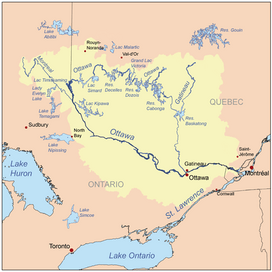Ottawa River drainage basin facts for kids
Quick facts for kids Ottawa River drainage basin |
|
|---|---|

The Ottawa River drainage basin drains to the Saint Lawrence River, a large river that extends northeasterly from the Great Lakes.
|
|
| Geography | |
| Country | Canada |
The Ottawa River drainage basin is a large area of land in northern North America. All the surface water in this area, like rain and melting snow, flows into the Ottawa River and its connected lakes and streams. Think of it like a giant funnel that collects water for the river.
This basin covers about 146,300 square kilometers (56,500 square miles). That's a huge space! It is the 12th largest drainage basin in Canada. It stretches across parts of two Canadian provinces: Ontario and Quebec. The water from the Ottawa River eventually flows into the Saint Lawrence River, which is another very important river in Canada. The Ottawa River basin makes up about 11% of the total area that drains into the Saint Lawrence River.
Contents
What is a River Drainage Basin?
A river drainage basin, also called a watershed, is a region of land where all the water flows to a common point. This point is usually a river, lake, or ocean. Imagine drawing a line around all the high ground that separates one river system from another. Everything inside that line is part of the same drainage basin.
How Water Moves in a Basin
Water enters a basin in many ways. It can come from rain, snowmelt, or even underground springs. This water then travels downhill, forming small streams. These streams join together to create larger rivers. Eventually, all this water reaches the main river of the basin. The Ottawa River basin is a perfect example of this natural process.
Where is the Ottawa River Basin Located?
The Ottawa River basin is found in eastern Canada. It covers a significant part of both Ontario and Quebec. The Ottawa River itself forms part of the border between these two provinces.
Key Features of the Landscape
The land within the basin is quite varied. You'll find dense forests, many lakes, and wetlands. There are also some hilly areas, especially in the northern parts. This diverse landscape helps to collect and filter the water that flows into the Ottawa River. The basin's geography plays a big role in how water moves through it.
Why is the Ottawa River Basin Important?
The Ottawa River drainage basin is very important for many reasons. It provides drinking water, supports many types of plants and animals, and has been a key area for human activity for thousands of years.
Water for People and Cities
Millions of people live within or near the Ottawa River basin. The river and its tributaries provide fresh water for drinking, farming, and industry. Cities like Ottawa, the capital of Canada, rely heavily on this water source. Keeping the water clean is vital for everyone who lives here.
Home to Wildlife and Nature
The basin is a rich ecosystem. It is home to many different species of plants and animals. The forests provide habitats for deer, bears, and many bird species. The rivers and lakes are full of fish, such as walleye and pike. Protecting this natural environment is crucial for biodiversity.
A Look at the Basin's History
The Ottawa River basin has a long and fascinating history. For thousands of years, it has been a vital area for Indigenous peoples. Later, it became important for logging and trade.
Indigenous Peoples and the River
Long before European settlers arrived, the Ottawa River was a major transportation route for various Indigenous peoples like the Algonquin people. They used canoes to travel the river, trade goods, and hunt. The river was central to their way of life and culture. Many ancient sites and traditions are linked to the basin.
The Logging Era
In the 19th century, the Ottawa River became famous for its logging industry. Huge numbers of trees were cut down and floated down the river to sawmills. This industry helped build many towns and cities in the region. It also played a big part in Canada's early economy.
Hydroelectric Power Today
Today, the river is a major source of hydroelectric power. Dams along the Ottawa River and its branches generate electricity for homes and businesses. This clean energy source is important for reducing reliance on fossil fuels. These dams also help control water levels.
Protecting the Ottawa River Basin
Like many large river systems, the Ottawa River basin faces environmental challenges. Efforts are being made to protect its water quality and natural habitats for the future.
Environmental Challenges
Pollution from cities, farms, and industries can affect the river's health. Changes in land use, like building new developments, can also impact the basin. Climate change is another concern, as it can affect water levels and temperatures.
Conservation Efforts
Many groups and governments are working to protect the Ottawa River basin. They focus on cleaning up pollution, restoring natural habitats, and educating people about the importance of the river. These efforts help ensure that the basin remains healthy for future generations and the wildlife that depend on it.

